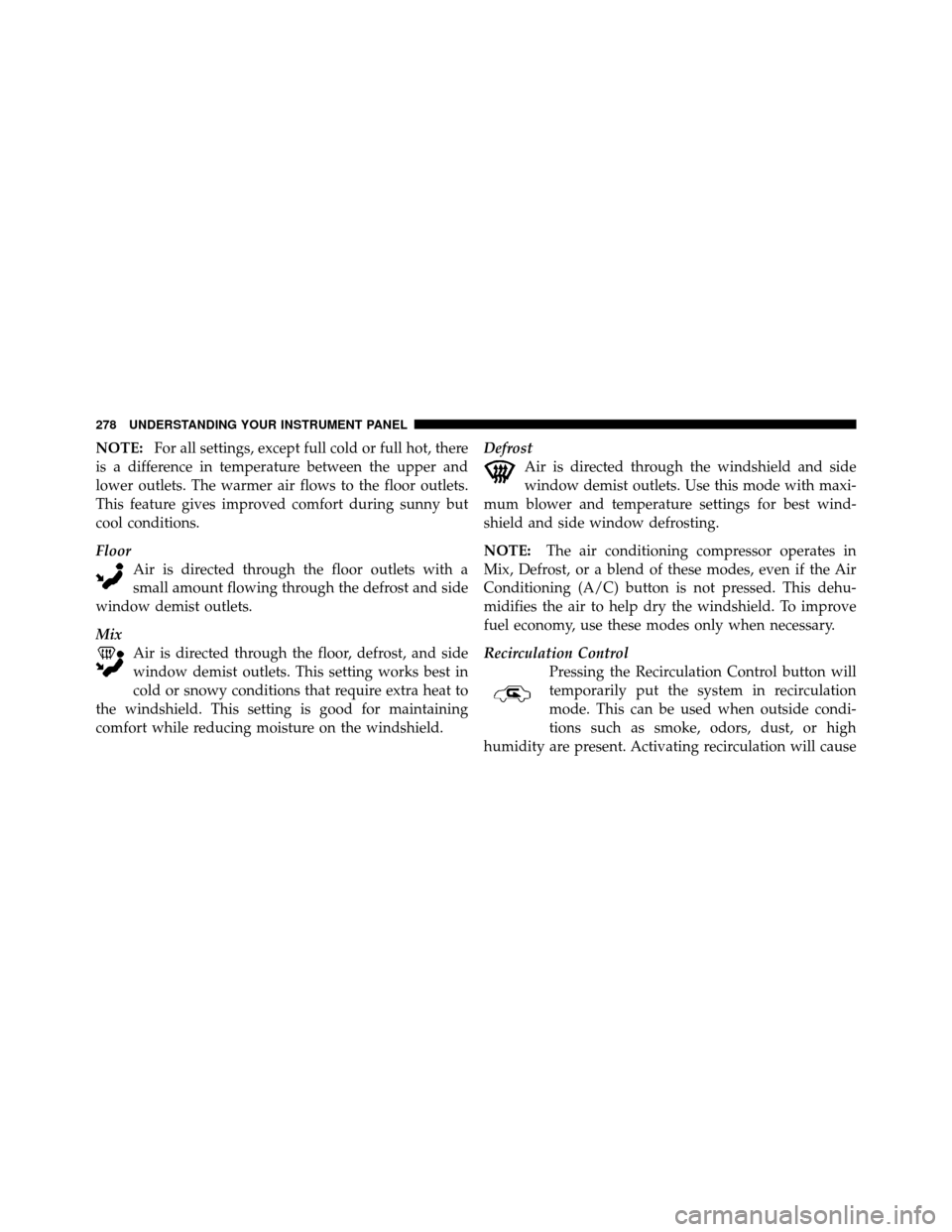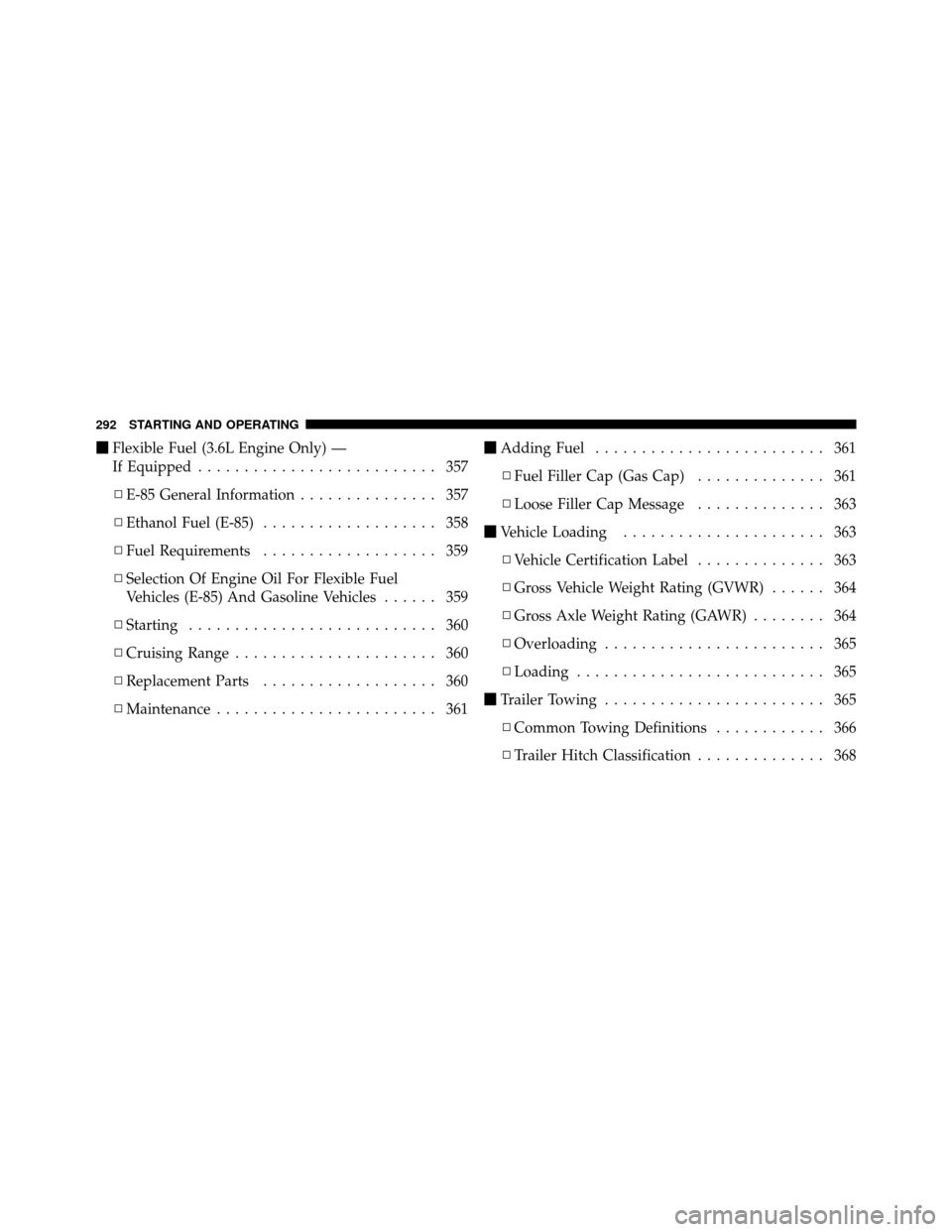Page 207 of 505

•The ESC system will make buzzing or clicking sounds
when it is active. This is normal; the sounds will stop
when ESC becomes inactive following the maneuver
that caused the ESC activation.
25. Tire Pressure Monitoring Telltale Light Each tire, including the spare (if provided),
should be checked monthly when cold and
inflated to the inflation pressure recommended
by the vehicle manufacturer on the vehicle
placard or tire inflation pressure label. (If your vehicle
has tires of a different size than the size indicated on the
vehicle placard or tire inflation pressure label, you should
determine the proper tire inflation pressure for those
tires.) As an added safety feature, your vehicle has been
equipped with a Tire Pressure Monitoring System
(TPMS) that illuminates a low tire pressure telltale when
one or more of your tires is significantly under-inflated.
Accordingly, when the low tire pressure telltale illumi-
nates, you should stop and check your tires as soon as
possible, and inflate them to the proper pressure. Driving
on a significantly under-inflated tire causes the tire to
overheat and can lead to tire failure. Under-inflation also
reduces fuel efficiency and tire tread life, and may affect
the vehicle’s handling and stopping ability.
Please note that the TPMS is not a substitute for proper
tire maintenance, and it is the driver ’s responsibility to
maintain correct tire pressure, even if under-inflation has
not reached the level to trigger illumination of the TPMS
low tire pressure telltale.
4
UNDERSTANDING YOUR INSTRUMENT PANEL 205
Page 209 of 505

the bulb does not come on when turning the key from
LOCK to ON/RUN, have the condition checked
promptly.
Certain conditions, such as a loose or missing gas cap,
poor fuel quality, etc., may illuminate the light after
engine start. The vehicle should be serviced if the light
stays on through several of your typical driving cycles. In
most situations, the vehicle will drive normally and will
not require towing.
CAUTION!
Prolonged driving with the MIL on could cause
damage to the engine control system. It also could
affect fuel economy and drivability. If the MIL is
flashing, severe catalytic converter damage and
power loss will soon occur. Immediate service is
required.
WARNING!
A malfunctioning catalytic converter, as referenced
above, can reach higher temperatures than in normal
operating conditions. This can cause a fire if you
drive slowly or park over flammable substances such
as dry plants, wood, cardboard, etc. This could result
in death or serious injury to the driver, occupants or
others.
27. Transmission Temperature Warning Light — If
Equipped This light indicates that the transmission fluid
temperature is running hot. This may occur
with severe usage, such as trailer towing. If this
light turns on, safely pull over and stop the
vehicle. Then, shift the transmission into NEUTRAL and
run the engine at idle or faster until the light turns off.
4
UNDERSTANDING YOUR INSTRUMENT PANEL 207
Page 215 of 505

•Remote start aborted — Fuel low
•Remote start disabled — System fault
•Convertible Top Not Secured (with a single chime)
•Convertible Top Complete (with a single chime)
•Secure Cargo Shield (with a single chime)
•Speed Too High (with a single chime)
•Convertible Top Malfunction (with a single chime)
•Oil Change Required (with a single chime)
•ECO (Fuel Saver Indicator) — If Equipped
•Low Pressure (with a single chime) Refer to�Ti re
Pressure Monitoring System� in�Starting and Operat-
ing�.
•Check TPM System (with a single chime) Refer to �Ti re
Pressure Monitoring System� in�Starting and Operating�.
Oil Change Required — If Equipped
Your vehicle is equipped with an engine oil change
indicator system. The “Oil Change Required” message
will flash in the EVIC display for approximately five
seconds after a single chime has sounded to indicate the
next scheduled oil change interval. The engine oil change
indicator system is duty cycle based, which means the
engine oil change interval may fluctuate dependent upon
your personal driving style.
Unless reset, this message will continue to display each
time you turn the ignition switch to the ON/RUN
position. To turn off the message temporarily, press and
release the Menu button. To reset the oil change indicator
system (after performing the scheduled maintenance),
perform the following procedure:
1. Turn the ignition switch to the ON position (Do not
start the engine.)
4
UNDERSTANDING YOUR INSTRUMENT PANEL 213
Page 216 of 505

2. Fully depress the accelerator pedal slowly three times
within 10 seconds.
3. Turn the ignition switch to the LOCK position.
NOTE:If the indicator message illuminates when you
start the vehicle, the oil change indicator system did not
reset. If necessary repeat this procedure.
Trip Functions
Press and release the MENU button until one of the
following Trip Functions displays in the EVIC:
•ECO (Fuel Saver Indicator) — If Equipped
•Average Fuel Economy
•Distance To Empty
•Elapsed Time
•Display Units of Measure in Press and release the DOWN button to advance the
display through the Trip Functions.
The Trip Functions mode displays the following informa-
tion:
•ECO (Fuel Saver Indicator) — If Equipped
The ECO indicator will illuminate in the EVIC display.
This ECO message will appear when you are driving in a
fuel efficient manner and can be used to modify driving
habits in order to increase fuel economy.
•Average Fuel Economy
Shows the average fuel economy since the last reset.
When the fuel economy is reset, the display will read,
RESET or show dashes for two seconds. Then, the history
information will be erased, and the averaging will con-
tinue from the last fuel average reading before the reset.
214 UNDERSTANDING YOUR INSTRUMENT PANEL
Page 217 of 505

•Distance To Empty (DTE)
Shows the estimated distance that can be traveled with
the fuel remaining in the tank. This estimated distance is
determined by a weighted average of the instantaneous
and average fuel economy, according to the current fuel
tank level. DTE cannot be reset through the SELECT
button.
NOTE: Significant changes in driving style or vehicle
loading will greatly affect the actual drivable distance of
the vehicle, regardless of the DTE display value.
When the DTE value is less than 30 miles (48 km)
estimated driving distance, the DTE display will change
to a text display of LOW FUEL. This display will con-
tinue until the vehicle runs out of fuel. Adding a signifi-
cant amount of fuel to the vehicle will turn off the LOW
FUEL text and a new DTE value will display.•Elapsed Time
Shows the total elapsed time of travel since the last reset.
Elapsed time will increment when the ignition switch is
in the ON or START position.
•Display Units In:
To make your selection, press and release the SELECT
button until “ENGLISH” or “METRIC” appears.
To Reset The Display
Reset will only occur if a resettable function is currently
displayed. Press and hold the SELECT button once to
clear the function currently displayed.
To reset all resettable functions, press and release the
SELECT button a second time within three seconds of
resetting the currently displayed function (Reset ALL will
display during this three-second window).
4
UNDERSTANDING YOUR INSTRUMENT PANEL 215
Page 280 of 505

NOTE:For all settings, except full cold or full hot, there
is a difference in temperature between the upper and
lower outlets. The warmer air flows to the floor outlets.
This feature gives improved comfort during sunny but
cool conditions.
Floor Air is directed through the floor outlets with a
small amount flowing through the defrost and side
window demist outlets.
Mix Air is directed through the floor, defrost, and side
window demist outlets. This setting works best in
cold or snowy conditions that require extra heat to
the windshield. This setting is good for maintaining
comfort while reducing moisture on the windshield. Defrost
Air is directed through the windshield and side
window demist outlets. Use this mode with maxi-
mum blower and temperature settings for best wind-
shield and side window defrosting.
NOTE: The air conditioning compressor operates in
Mix, Defrost, or a blend of these modes, even if the Air
Conditioning (A/C) button is not pressed. This dehu-
midifies the air to help dry the windshield. To improve
fuel economy, use these modes only when necessary.
Recirculation Control Pressing the Recirculation Control button will
temporarily put the system in recirculation
mode. This can be used when outside condi-
tions such as smoke, odors, dust, or high
humidity are present. Activating recirculation will cause
278 UNDERSTANDING YOUR INSTRUMENT PANEL
Page 293 of 505

▫Tire Inflation Pressures ................ 333
▫ Radial-Ply Tires ..................... 335
▫ Spare Tire Matching Original Equipped Tire
And Wheel – If Equipped .............. 336
▫ Compact Spare Tire – If Equipped ........ 336
▫ Full Size Spare – If Equipped ............ 337
▫ Limited-Use Spare – If Equipped ......... 338
▫ Tire Spinning ....................... 338
▫ Tread Wear Indicators ................. 339
▫ Life Of Tire ........................ 340
▫ Replacement Tires .................... 340
� Tire Chains .......................... 341
� Snow Tires .......................... 342 �
Tire Rotation Recommendations ........... 342
� Tire Pressure Monitor System (TPMS) ....... 343
▫ Base System ........................ 346
▫ Premium System – If Equipped .......... 348
▫ General Information .................. 352
� Fuel Requirements ..................... 353
▫ Reformulated Gasoline ................ 353
▫ Gasoline/Oxygenate Blends ............. 354
▫ E-85 Usage In Non-Flex Fuel Vehicles ...... 354
▫ MMT In Gasoline .................... 355
▫ Materials Added To Fuel ............... 355
▫ Fuel System Cautions ................. 356
▫ Carbon Monoxide Warnings ............ 357
5
STARTING AND OPERATING 291
Page 294 of 505

�Flexible Fuel (3.6L Engine Only) —
If Equipped .......................... 357
▫ E-85 General Information ............... 357
▫ Ethanol Fuel (E-85) ................... 358
▫ Fuel Requirements ................... 359
▫ Selection Of Engine Oil For Flexible Fuel
Vehicles (E-85) And Gasoline Vehicles ...... 359
▫ Starting ........................... 360
▫ Cruising Range ...................... 360
▫ Replacement Parts ................... 360
▫ Maintenance ........................ 361 �
Adding Fuel ......................... 361
▫ Fuel Filler Cap (Gas Cap) .............. 361
▫ Loose Filler Cap Message .............. 363
� Vehicle Loading ...................... 363
▫ Vehicle Certification Label .............. 363
▫ Gross Vehicle Weight Rating (GVWR) ...... 364
▫ Gross Axle Weight Rating (GAWR) ........ 364
▫ Overloading ........................ 365
▫ Loading ........................... 365
� Trailer Towing ........................ 365
▫ Common Towing Definitions ............ 366
▫ Trailer Hitch Classification .............. 368
292 STARTING AND OPERATING